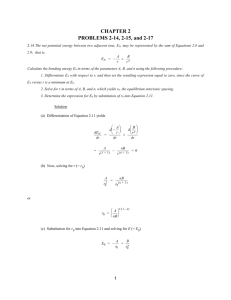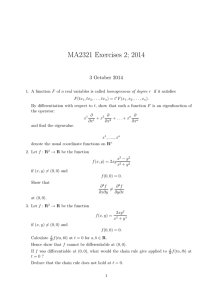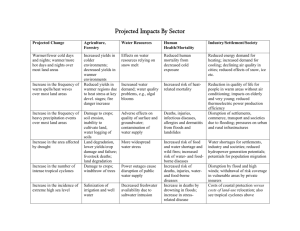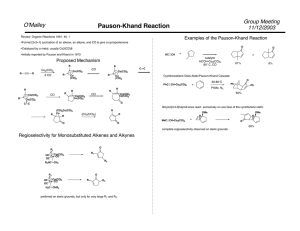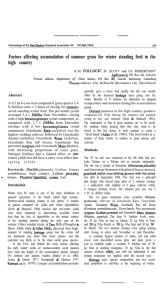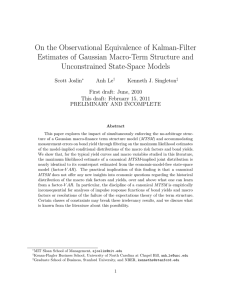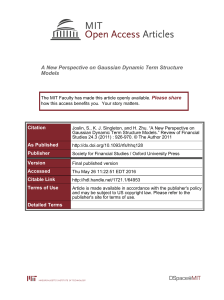November 30, 2004 Lecturer Dmitri Zaitsev Hilary Term 2005
advertisement
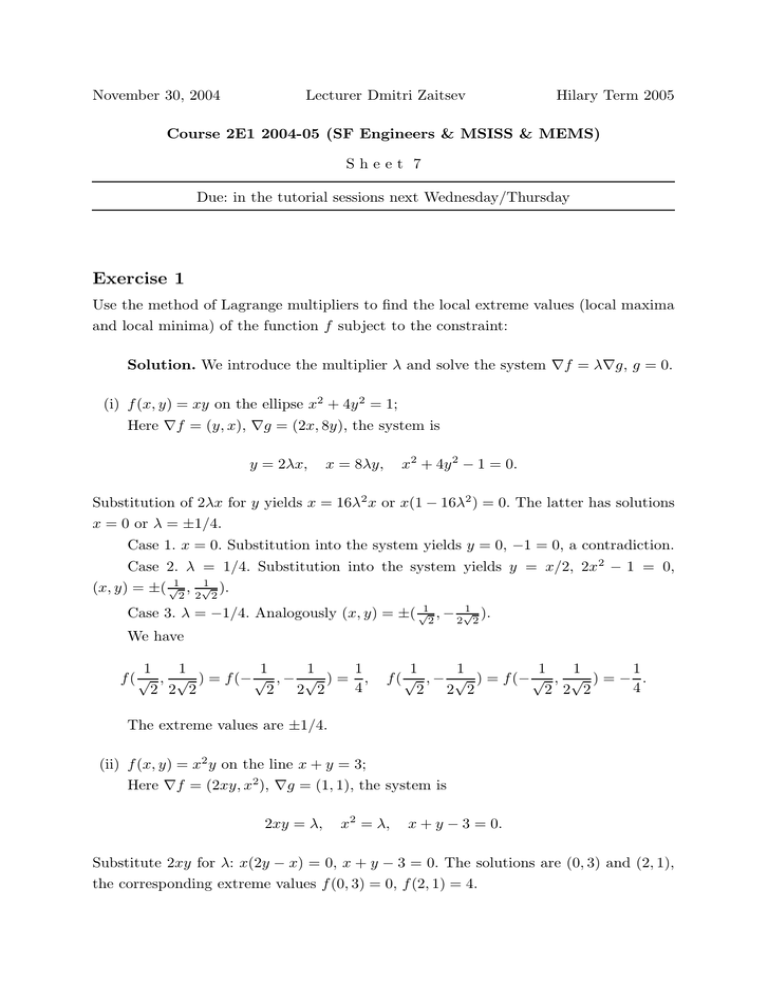
November 30, 2004 Lecturer Dmitri Zaitsev Hilary Term 2005 Course 2E1 2004-05 (SF Engineers & MSISS & MEMS) Sheet 7 Due: in the tutorial sessions next Wednesday/Thursday Exercise 1 Use the method of Lagrange multipliers to find the local extreme values (local maxima and local minima) of the function f subject to the constraint: Solution. We introduce the multiplier λ and solve the system ∇f = λ∇g, g = 0. (i) f (x, y) = xy on the ellipse x2 + 4y 2 = 1; Here ∇f = (y, x), ∇g = (2x, 8y), the system is y = 2λx, x2 + 4y 2 − 1 = 0. x = 8λy, Substitution of 2λx for y yields x = 16λ2 x or x(1 − 16λ2 ) = 0. The latter has solutions x = 0 or λ = ±1/4. Case 1. x = 0. Substitution into the system yields y = 0, −1 = 0, a contradiction. Case 2. λ = 1/4. Substitution into the system yields y = x/2, 2x2 − 1 = 0, 1 (x, y) = ±( √12 , 2√ ). 2 1 Case 3. λ = −1/4. Analogously (x, y) = ±( √12 , − 2√ ). 2 We have 1 1 1 1 1 f ( √ , √ ) = f (− √ , − √ ) = , 4 2 2 2 2 2 2 1 1 1 1 1 f ( √ , − √ ) = f (− √ , √ ) = − . 4 2 2 2 2 2 2 The extreme values are ±1/4. (ii) f (x, y) = x2 y on the line x + y = 3; Here ∇f = (2xy, x2), ∇g = (1, 1), the system is 2xy = λ, x2 = λ, x + y − 3 = 0. Substitute 2xy for λ: x(2y − x) = 0, x + y − 3 = 0. The solutions are (0, 3) and (2, 1), the corresponding extreme values f (0, 3) = 0, f (2, 1) = 4. (iii) f (x, y) = 2x − y + 6 on the circle x2 + y 2 = 4; Here ∇f = (2, −1), ∇g = (2x, 2y), the system is 2 = 2λx, −1 = 2λy, x2 + y 2 − 4 = 0. From the first equation λ = 6 0, hence we can solve x = 1/λ, y = −1/2λ. Substituting √ in the third equation and solving yields λ = ± 5/4 and hence (x, y) = ( √45 , − √25 ) or (x, y) = (− √45 , √25 ). The extreme values are obtained by evaluating f at these points. (iv) f (x, y, z) = xyz on the plain x + y + z = 1. Here ∇f = (yz, xz, xy), ∇g = (1, 1, 1), the system is yz = λ, xz = λ, xy = λ, x + y + z − 1 = 0. From the first equation λ = yz, substitute in the second: xz = yz or (x − y)z = 0. Case 1. z = 0 yields λ = 0, xy = 0 with two solutions (0, 1, 0) and (1, 0, 0), where the value of f is 0. Case 2. z 6= 0 yields x = y and hence yz = λ = xy yields y(z − y) = 0. If y = 0, it follows from the last equation that z = 1 and we have the solution (0, 0, 1) with the value of f being 0. Finally, if y = z, we have x = y = z = 1/3 and the solution (1/3, 1/3, 1/3) with the value of f being 1/27. Hence we have two possible extreme values 0 and 1/27. (v) f (x, y, z) = x + 2y + 3z on the sphere x2 + y 2 + z 2 = 25. Here ∇f = (1, 2, 3), ∇g = (2x, 2y, 2z), the system is 1 = 2λx, 2 = 2λy, 3 = 2λz, x2 + y 2 + z 2 − 25 = 0. Exercise 2 Minimize the function f subject to two constraints: Solution. Here we have two constraints g1 = 0 and g2 = 0 and thus need two multipliers λ and µ and the system becomes ∇f = λ∇g1 + µ∇g2 , g1 = 0, g2 = 0. (i) f (x, y, z) = xyz on the intersection of x2 + y 2 − 1 = 0 and x − z = 0; Solution. The system becomes (yz, xz, xy) = λ(2x, 2y, 0) + µ(1, 0, −1), x2 + y 2 − 1 = 0, x−z = 0 or yz = 2λx + µ xz = 2λy xy = −µ 2 2 x + y − 1 = 0 x−z =0 Expressing µ from the third and z from the last equation and substuting, we get z = x µ = −xy 2xy = 2λx 2 x2 = 2λy x + y 2 − 1 = 0. Next we want to eliminate λ but we have to divide e.g. by x in the third equation. This is only allowed if x 6= 0, so we have to treat cases: Case 1. x = 0 which yields λ = 0 and y = ±1, hence two points (0, ±1, 0). The value of f at both points is 0. Case 2. x 6= 0 and we get λ = y, hence x2 = 2y 2 from the 4th equation. Substitution p √ into the last one yields 3y 2 = 1 or y = ±1/ 3 and z = x = ± 2/3. Here the signs for x and y can be chosen independently and z = x from the first equation. Hence we obtain 4 solutions: (− p √ p ( 2/3, 1/ 3, 2/3), ( p √ p 2/3, −1/ 3, 2/3), p p √ 2/3, 1/ 3, − 2/3), (− p p √ 2/3, −1/ 3, − 2/3) 2 leading to the values of f equal to ± 3√ . The required minimum is the minimum of the 3 2 . values obtained which is − 3√ 3 (ii) f (x, y, z) = x2 + y 2 + z 2 on the intersection of y + 4z − 4 = 0 and 4y 2 − z 2 = 0. Solution. Now the required system becomes (2x, 2y, 2z) = λ(0, 1, 4) + µ(0, 8y, −2z), y + 4z − 4 = 0, or 2x = 0 2y = λ + 8yµ 2z = 4λ − 2zµ 4=0 y +2 4z − 4y − z 2 = 0. 4y 2 − z 2 = 0 The first equation gives x = 0 and the last two equations give two solutions for y and z. The values of f at the points obtained are to be compared and the minimal value is the desired minimum. Note that f has no maximum under the given constraints because x2 can be arbitrarily large.

